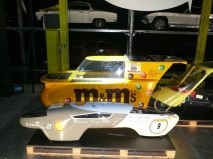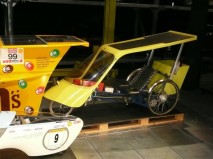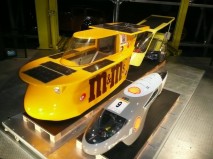2005 PAC Car II
Country - Swiss
Number of seats - 1
Weight - 29 kg
Speed - 32 km h
Engine type - Electric motor (fuel cells), Direct current electric motor
Power - 0.9kW (1.2 hp)
Pac-Car II is the world's most fuel-economic vehicle. It was developed as a student project at ETH Zürich (Swiss Federal Institute of Technology). Based on a group of students and an experienced teamleader, the goal was to build a vehicle that uses as little fuel as possible. By using hydrogen fuel-cell, developed at ETH/PSI (Paul Scherrer Institute), as power source, pure water is the car's only emission. Clean mobility completed therefore the educational and energy saving aspects of the project.
- Excellent aerodynamics (drag coefficient of Cd=0.075, Af=0.254 m²)
- an extremely lightweight construction of the body (total mass of 29 kg, carbon fibre materials)
- low rolling resistance of Michelin's Radial Tyres (Cr=0.0008)
- highly efficient powertrain (almost 50%)
- use of simulation and optimization tools (CFD, FEM, MATLAB and Simulink, GESOP)
In 2005 on June 26, PAC-Car II set a new world record in fuel-economy of 5385 km/l gasoline equivalence during the Shell Eco-Marathon in Ladoux, France. During its third race over 20.6 km the car consumed approximately 1 g of Hydrogen driving at an average speed of 30 km/h (roughly 18.6 mph). This corresponds to 0.0186 L/100 km (15,200 mpg-imp; 12,600 mpg-US) gasoline equivalence. This world record is certified by the Guinness Book of World Records.














